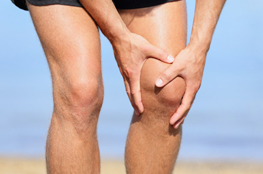 Osteoarthritis (not to be confused with rheumatoid arthritis) is also called degenerative joint disease. It is not really a disease but more a degenerative process that causes joint cartilage to slowly break down. This breakdown removes the buffer (cartilage) between bones, and the resulting bone-against-bone friction causes pain and eventual loss of movement. Symptoms include joint pain or aching (often after exercise or extended periods of pressure on weight-bearing joints) and limited or eventual loss of range of motion.
Osteoarthritis (not to be confused with rheumatoid arthritis) is also called degenerative joint disease. It is not really a disease but more a degenerative process that causes joint cartilage to slowly break down. This breakdown removes the buffer (cartilage) between bones, and the resulting bone-against-bone friction causes pain and eventual loss of movement. Symptoms include joint pain or aching (often after exercise or extended periods of pressure on weight-bearing joints) and limited or eventual loss of range of motion.
Cartilage is a living tissue that grows, breaks down and repairs itself on the joint surfaces to provide smooth, friction-free movement.
Under normal circumstances, the breakdown and repair – with the help of cells called chondrocytes – will match each other and create a status quo, which will result in a healthy joint. But an excess of biomechanical stress will disturb the balance between breakdown and repair, and the chondrocytes will be unable to keep up with the repair of the cumulative damage caused by the breakdown of the cartilage. The result will be a loss of density and elasticity and subsequent little cracks in the cartilage. The end result of this process is osteoarthritis.
There is a wide array of factors that cause the development and progression of the disease. As it is basically an excess of wear and tear on the joint surfaces, common risk factors include:
- Aging
- Obesity
- Joint injuries (sports, work or accidents)
- Genetics
- Weight management to relieve stress on weight-bearing joints
- Anti-inflammatory drugs for degenerative joint disorders
- Synovectomy (surgical removal of inflamed synovial tissue)
- Osteotomy (restructuring of the bones to shift stresses from diseased to more healthy tissue)
- Partial knee replacements (unicompartmental knee)
- Total knee replacement
- Physical therapy
Osteoarthritis affects an estimated 21 million people in the United States and is characterized by mild to debilitating pain in the joints such as hands, knees, hips, feet and back. According to the Arthritis Foundation, the disease is most prevalent among individuals 45 years of age and older. Women are more prone to the disease. The therapists at ARC Physical Therapy and Pain Center use physical therapy, manual techniques, soft tissue massage to:
- Significantly reduce pain by treating the swelling around various knee tendons and knee capsule.
- Increase the motion in the joint.
- Minimize the loss of muscle mass and knee stability by joint and muscle exercises to improve strength and flexibility.
Modalities such as ultrasound, ice, heat and medical acupuncture are used to loosen up the muscle tissue and increase the blood flow to the injured area, starting the healing process by providing access of nutrition and oxygen to the injured area.
Conditions Treated
-
- Bursitis
- Carpal Tunnel Syndrome
- Chronic Fatigue Syndrome
- Circulation
- Fibromyalgia
- Foot & Heel Pain
- Frozen Shoulder
- Herniated Disk
- Lower Back Pain
- Lumbar Spinal Stenosis
- Migraines
- Neck Pain
- Osteoarthritis
- Peripheral Neuropathology
- Piriformis Syndrome
- Poor Posture
- Rheumatoid Arthritis
- Rotator Cuff
- Sciatica
- Shingles
- Sinusitis
- Tennis Elbow
- TMJ